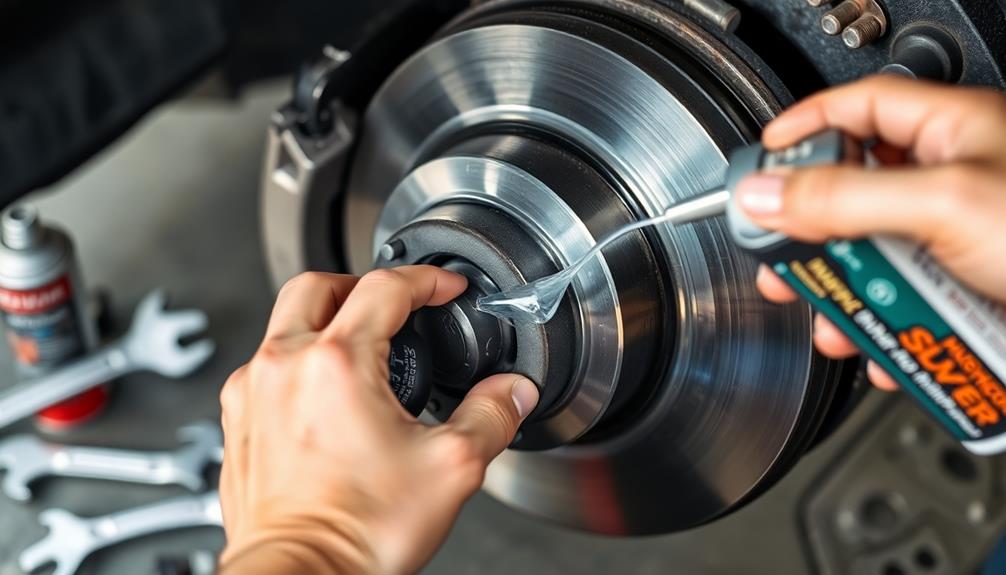To DIY replace your wiper blades, start by lifting the wiper arm and inspecting the attachment clip, making sure it matches your new blades. Remove the old blades by releasing the clip and sliding them out. Attach the new blades by sliding them onto the clip until they click into place, then gently lower the wiper arm back onto the windshield. Test the blades to guarantee they clear your windshield effectively—learn more to perform the replacement smoothly and safely.
Key Takeaways
- Inspect existing wiper blades for signs of wear, such as cracks, tears, or streaks.
- Clean the rubber edges of the blades before removal to ensure clear visibility during replacement.
- Carefully lift the wiper arm and release the attachment clip to detach the old blade.
- Match and secure the new blade to the wiper arm, ensuring it clicks into place properly.
- Test the new blades by activating the wipers to confirm smooth movement and effective clearing.

Replacing your wiper blades yourself is a simple and cost-effective way to guarantee clear visibility during bad weather. When you stay on top of wiper blade maintenance, you ensure your windshield remains streak-free and your view stays unobstructed. Over time, wiper blades can become cracked, torn, or less effective, especially after harsh winter months or intense sun exposure. Recognizing when to replace them and knowing how to do it yourself saves you money and time, and it keeps your driving safer.
To begin, inspect your current wiper blades. Look for signs of wear such as cracks, tears, or missing chunks of rubber. Also, if your blades leave streaks or don’t clear the windshield effectively, it’s time for new ones. Regular maintenance involves more than just replacing the blades; it includes cleaning the blades themselves. Use a damp cloth or a specialized windshield cleaner to wipe the rubber edge, removing dirt and debris that can hinder their performance. Proper wiper blade maintenance helps prolong their lifespan and maintains ideal windshield clarity.
When you’re ready to replace the blades, start by lifting the wiper arm away from the windshield. Be careful, as the arm is spring-loaded and can snap back if not handled gently. Most blades have a small metal or plastic clip that holds them onto the wiper arm. To remove the old blade, release this clip—usually by pressing or sliding it—then slide the blade out of its hook or connector. Examine the attachment mechanism on your new blades to ensure they match; most come with universal adapters, but some older models might require specific fittings.
Installing the new wiper blade is straightforward. Slide the new blade into the hook or connector until you hear a click or feel it lock into place. Once secured, gently lower the wiper arm back onto the windshield. Repeat the process for the other side, and then test your new blades by turning on the windshield wipers. Make sure they move smoothly across the glass and clear away rain or snow effectively. If they skip or streak, double-check that the blades are properly attached. Additionally, understanding the benefits of proper system efficiency can help you select the right blades for optimal performance.
Regularly inspecting and replacing your wiper blades ensures your windshield remains clear under all conditions. Good wiper blade maintenance isn’t just about convenience—it’s about safety. Clear visibility allows you to react quickly to hazards and prevents accidents caused by obstructed views. Plus, doing it yourself means you avoid unnecessary trips to the mechanic or auto shop, saving you money and giving you the confidence that your vehicle’s essential functions are in top shape.
Frequently Asked Questions
Can I Replace Wiper Blades Without Tools?
Yes, you can replace wiper blades without tools by using quick tool alternatives like a flat-head screwdriver or your fingers to release the clip. Follow DIY replacement tips by gently lifting the wiper arm and unclipping the blade. Make sure to handle the arm carefully to avoid damage. This simple method makes the process straightforward, saving you time and effort without needing specialized tools.
How Do I Know When to Replace My Wiper Blades?
You should replace your wiper blades when their lifespan reaches about six to twelve months or if you notice streaks, squeaking, or smudges. These signs indicate reduced visibility, especially in rain or snow. Changing them guarantees better clarity and safety on the road. Regularly inspecting your blades helps maintain peak visibility, preventing accidents caused by impaired windshield wiper performance. Don’t wait too long to replace for clearer, safer driving conditions.
Are There Different Wiper Blade Sizes for My Vehicle?
Yes, there are different wiper blade sizes for your vehicle. To find the right wiper blade measurements, check your vehicle’s owner’s manual or look at the existing blades for size markings. It’s important to make certain of compatibility, so verify that the wiper blades you choose match your vehicle’s specifications. Using the correct sizes guarantees proper fit and peak wiping performance, keeping your windshield clear and safe during driving.
Can I Install Wiper Blades in the Rain?
Yes, you can install wiper blades in the rain, but it’s best to wait for a dry moment if possible. On a rainy day, safety tips include parking your vehicle securely, turning on your hazard lights, and working carefully to avoid slipping. Make sure the windshield is clear, and follow the installation instructions precisely. This way, you’ll guarantee your new wipers work effectively and stay safe during the process.
What Safety Precautions Should I Take During Replacement?
You should wear protective gear like gloves and safety glasses to prevent injuries and safeguard your eyes. Make sure the car is turned off and the parking brake is engaged to guarantee stability. Avoid contact with electrical components, and disconnect the battery if necessary, for electrical safety. Work in a well-lit area, and handle blades carefully to avoid cuts. Following these precautions keeps you safe during the replacement process.
Conclusion
Replacing your wiper blades yourself is quick, easy, and saves you money. With just a few simple steps, you can guarantee clear visibility and safer driving in any weather. Did you know that regular wiper blade replacement can improve your windshield contact by up to 90%, enhancing visibility? So next time your blades streak or squeal, remember it’s a simple fix that keeps you safer on the road. Give it a try—your eyes will thank you!









